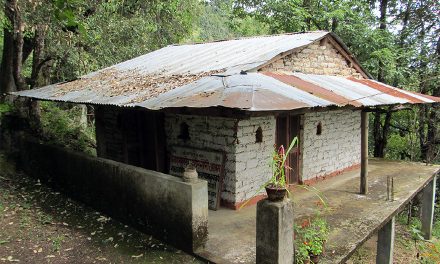In yesterday’s Feature story, we looked at Vishnupur’s role in Gaudiya Vaisnava history. Vishnupur was likened to ‘new Vrindavan’ during the reign of Aurangzeb’s demolition of Hindu temples in Vrindavan. Today we continue to explore the impact of this era on temple architecture and presence. In his 2008 article, Brij Bhoomi: the abode of Bhagwan Krishna writer V. Sundaram offers an interesting view of this period of history, which we paraphrase below.
The photograph above shows the stately Keshav Dev Temple at Mathura (Krishna Janma Bhoomi Temple). According to tradition, Brajanabh, the great grandson of Sri Krishna, was the Ruler who built this temple at the prison of Kamsa, where Bhagwan Krishna was born. There is historical evidence to show that this temple was rebuilt during the regime of Chandragupta Vikramaditya (375-413 CE), one of the great rulers of the Gupta Empire. He was a great worshipper of Maha Vishnu and Krishna.
In 1017 AD, this gracious temple was looted by Mahamood of Ghazni (who also savagely destroyed the Somnath Temple in Gujarat). This fact of Islamic history has been noted in the book, Tarike Yamini by Mir Munshi Al-Utabi. During the reign of Maharana Vijaypal Dev of Mathura, this temple was rebuilt again in 1150 AD.
We can see from the epigraphical evidence in Sanskrit found on the temple premises that this temple has been a target of destruction in the eye of Muslim rulers since the days of Mohammed of Ghazni. During the regime of Sikander Lodi from 1489 to 1517, Krishna Janma Bhoomi was once again destroyed. Again, after about 125 years, during the rule of Mughal Emperor Jahangir (1605 to 1627), Vir Sinha Judev Bundela, a Rajput King, constructed a very huge temple 250 feet tall, at a cost of Rs.33 lakhs. In order to protect this temple from the evil eye of Muslim rulers, a tall and strong wall was built around the temple. Even today, remnants of this wall are evident.
Once can clearly see the Muslim mosque on the left side of the Katara Keshav Dev Temple at Mathura (above). Aurangazeb (1618-1707), the Mughal Emperor from 1658 to 1707, was also a barbarous and savage destroyer of Hindu Temples. It was he who destroyed portions of the Krishna Janma Bhoomi Temple at Mathura and built a mosque there.
In 1968, the Sri Krishna Janmasthan Seva Sangh, the Trust looking after the temple built at Sri Krishna’s birthplace in Mathura, entered into an agreement with the Shahi Masjid Idgah located just behind the temple in Mathura. Under this agreement, all legal proceedings between the two parties, dating back to more than a century, were withdrawn. Thirty years later, the Vishwa Hindu Parishad (VHP) launched a movement for the liberation of the Krishna Janma Bhoomi Temple in Mathura, and their efforts to fully reclaim Sri Krsna’s property are ongoing to this day.
Govind Dev Temple at Vrindavan
The Govind Dev Temple at Vrindavan, near Mathura, was built in 1590 AD by Maharaja Man Singh of Jaipur. The upper part of this temple was destroyed on Aurangazeb’s orders, in anticipation of his visit to Vrindavan in 1670 AD.
Aurangazeb had the temple partially destroyed because he was very worried about a bright light shining in the far distance, on the southeast horizon of Delhi. In reply to his enquiries regarding it, he was told that it was a light burning in a temple of great wealth and magnificence at Vrindavan. He therefore resolved that the light should be put out, and soon after sent his troops to Vrindavan. They plundered and threw down as much of the temple as they could, then erected on the top of the ruins a mosque (a Mehrab or prayer hall) where, in order to complete the destruction, Aurangazeb offered up his prayers to Allah.
In the sketch below, we see the mosque super-imposed upon Gobind Dev Temple. The present temple plinth is 105 feet by 117 feet, but it is estimated that the original height was about 110 feet. Without this added height, it would not have been possible for Aurangazeb to see the mashaal or torch, either from Agra or from Delhi.
The beheaded temple turned mosque. The mehrab was removed by F. S. Growse, Magistrate of Mathura District, and the temple was restored to the Vaisnava community in 1871
In ordering the removal of the mosque from the temple, civil servant Growse aimed to redeem whatever original character was left of the temple. The original Deity of Sri Govindadeva had been shifted to Amber, Jaipur in 1670, just before the destruction of the temple, and continued to reside in Jaipur. Therefore, another set of Deities was installed by the pujaris when Mr. Growse handed the temple back to the Vaisnava community.
As described by Prafull Goradia in his book, Hindu Masjids, “Probably, no other desecrated temple had been the subject of so much repair and refurbishment by British Rulers. Of supreme importance was the fact of the Gobind Dev Temple at Vrindavan being restituted to Hindu devotees. It was the greatest act of Shuddhi or purification, although performed before Swami Dayanand Saraswathi (1824-1883) reintroduced Vedic procedures for Shuddhi. F S Growse therefore deserves a place in the Hall of Hindutva.”













beautiful beautiful beautiful